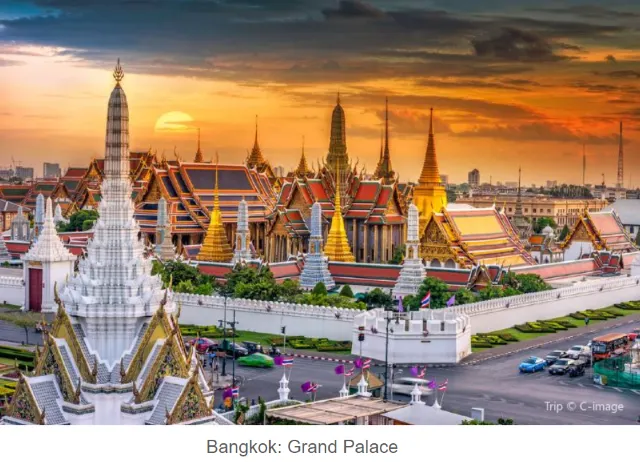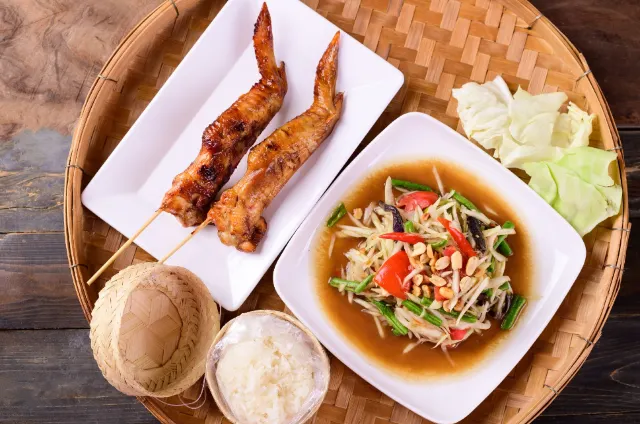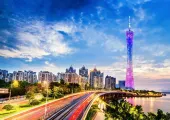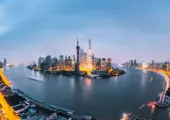Visit Bangkok: A Thailand Travel Guide (2022)
Catalogue
- 1. Tips For Your First Time In Bangkok, Thailand
- 2. How to get to Bangkok | Bangkok Airport Guide
- 3. Thailand International Travel Information
- 4. Getting Around Bangkok: Bangkok Public Transport & More
- 5. Best Times to Visit Bangkok - Bangkok Weather
- 6. Top 3 Things To Do And Must See Attractions In Bangkok
- 7. What To Eat In Bangkok - Local Foods You Must Try When Visiting Bangkok
- 8. Where To Shop in Bangkok, Thailand
- 9. Exploring Bangkok and Local Culture
- 10. Unique Experiences in Bangkok
Show More

Thailand conjures up images of elephants, temples, beaches, and of course, delicious food. The Southeast Asian nation is a major regional hub and, prior to the onset of COVID-19, was a massively popular travel destination. Fortunately, with vaccination rates on the rise, Thailand has decided to reopen its borders to fully vaccinated travelers from 63 countries and regions. In this article, we walk you through Thailand's new travel restrictions and what you have to do to get yourself booked for a vacation in this truly splendid travel destination.
Energetic, chaotic, and majestic, these are just a few words that come to mind when describing Bangkok. The heart and capital of Thailand, Bangkok is one of the most sprawling and metropolitan cities in Asia, and a popular gateway into the country. A city that has deeply rooted traditions and cosmopolitan attitudes, Bangkok has abundant cultural fascinations to captivate travelers from all over the world.
Located close to the Gulf of Thailand, Bangkok is a city of waterways with the Chao Phraya River flowing through it. Back in the 19th century, as most of the city’s residents lived near or on the water, the city is known as the “Venice of the East.” While the history of Bangkok dates back about 600 years, it didn’t become the capital city until the 18th century. Through trade and commerce, the city expanded to its current scale. Today tourism is one of the major sources of revenue in Bangkok.

With a tropical monsoon climate, the capital is hot and humid year-round. The most pleasant months to visit are from November to March when the heat and humidity are at their lowest. But this also means crowds are at their peak in late Fall and Winter, and this is particularly true around the Christmas and New Year’s holidays. If you don’t mind the monsoon season, July and August are the off-peak seasons where many good deals are available on hotels and flights.
There are so many first-rate scenic spots on offer in Bangkok, it is impossible to see them all if you only have a few days. For major tourist attractions in Bangkok, most are historical or religious sites. Make sure you admire the amazing architectural design of the Grand Palace and Wat Arun, pay homage to the sacred Jade Buddha (Wat Phra Kaew) or the Reclining Buddha (Wat Pho), or cruise past the temples and mansions on the Chao Phraya River (River of Kings). It is worth noting that, as many sites are sacred, there are strict rules which all visitors must follow. For instance, dress codes at the Grand Palace and various temples, men must wear long pants, shirts with sleeves, and no bare feet are permitted. Women must wear modest clothing that covers knees and shoulders.
For first-timers, Bangkok’s size, traffic, and crowds can seem impossible to navigate. Here are a few tips to ease you into this fascinating city. First up, how to get around Bangkok? The Suvarnabhumi Airport is about 30 km (19 miles) from central Bangkok. The fastest way is by Airport Rail Link, which for 35 Baht it connects you to an MRT station or 40 Baht to a Skytrain station in town. Alternatively, taxis are available outside the Arrivals Hall. Be sure to use the official taxi queue where staff is on hand to help. For traveling around the city, the Skytrain and the MRT subway are your quickest and most budget-friendly options.
Next up, where to stay? Depending on the purpose of your visit, here are a few popular areas to consider. Siam Square is a great location for people who love to shop as its full of luxury malls, bookstores, trendy boutiques, and easy access to the Skytrain. If you want to be close to the top attractions in town (e.g. Grand Palace), then Bangkok Old Town is the place for you. While this historic area is fairly small, it is ideal for exploration on foot. If you are on a budget, Khao San Road is a favorite area of backpackers. It’s centrally located and has many affordable hotel options. The drawback is that there is no Skytrain or Metro nearby.
Known for its complex tastes, Thai cuisine is one of the most recognizable and beloved in the world, make sure you sample some local favorites include papaya salad, spicy Thai soup, Pad Thai, and green curry. If you love to shop, you are in for a treat in Bangkok, from exclusive malls like Icon Siam Mall and CentralWorld to bustling local markets like Chatuchak Weekend Market and Sampeng Lane, this city has got you covered.
Being a major air transport hub in Asia, two international airports are serving Bangkok and its surrounding areas. One is the older Don Mueang International Airport, today it is mainly used for regional commuter flights and low-cost airlines. The other airport is the newer main airport of Bangkok – Suvarnabhumi Airport (BKK). One of the biggest international airports in Southeast Asia, the BKK has two international and one domestic terminal, and it is served by over 60 airlines. The airport has internal airport shuttle bus services providing free connections between Terminal buildings (outside the arrivals halls), VIP Rooms Building, and Car Park Building, etc.
Suvarnabhumi Airport is approximately 30 km (19 miles) from central Bangkok. Numerous transfers options are available between the airport and city center, including Airport Rail Link, taxis, public buses, and limousines. The fastest way is by Airport Rail Link. From Arrivals Hall visitors should follow the signs for the train station. For MRT/Subway connection, get off at Makkasan Station (fifth stop). From there, passengers can interchange with MRT Blue Line (Phetchaburi Station) for their final downtown destinations. Fare from Suvarnabhumi Airport to Makkasan Station is 35 Baht. If passengers take the Airport Rail Link to its terminal station, Phaya Thai Station, a connection can be made to the Skytrain (an elevated rapid transit system in Bangkok). Fare from Suvarnabhumi Airport to Phayathai Station is 45 Baht.
Other airport transfer options include the public buses which operate 24 hours a day for 35 Baht per trip. Passengers need to take an airport shuttle from the Arrivals Hall to the transportation center, where there are 11 routes from the airport to various parts of Bangkok. For a hassle-free alternative, visitors can grab a taxi outside the Arrivals Hall (Ground Level). Get a ticket from a taxi queue machine which shows the lane number on the ticket.
Officially called the Kingdom of Thailand, it was formerly known as Siam until 1949. Covering an area of around 514,000 sq.km. (198,456 sq.mi.), Thailand is one of the largest countries in Asia and the 51st biggest in the world. Located in the heart of mainland Southeast Asia, it is bordered by Laos to the north, Cambodia to the east, Malaysia to the south, and Myanmar to the west. There are 76 provinces and 2 specially governed districts which are Bangkok (the capital) and Pattaya.
Thailand has a population of around 70 million people, and it is a multi-ethnic nation with 62 recognized ethnic communities. The official language of Thailand is Thai. But the country is home to 71 living languages, for example, Lao is spoken along borders with Laos, and Malay is used in border regions with Malaysia.
There is only one time zone in Thailand – the Indochina Time (ICT) and it is always 7 hours ahead of GMT (Greenwich Mean Time). The ICT is used all year round, so there are no Daylight-Saving Time clock changes. Thailand is in the same time zone as Vietnam, Cambodia, and Laos.
Bangkok is known for its chaotic traffic and seemingly never-ending rush hours. When the roads appear to be perpetually clogged, the best options to travel around the city are the BTS (Skytrain) and the MRT (subway). The Skytrain is an efficient elevated train system that consists of 61 stations along three lines (BTS Sukhumvit Line, BTS Silom Line, and Gold Line). Interchanging between the Skytrain and MRT is possible at only five BTS stations. Fares are from 16-59 Baht depending on distance traveled, while one-day passes cost 140 Baht. In comparison, the MRT subway only has two lines (Blue Line and Purple Line) and covers a smaller area. Trains run frequently every 5-10 minutes during the hours of 6 a.m. and midnight. Fares are from 15-50 baht. When changing between the BTS and MRT, a new ticket will need to be purchased. There are English signs in both transit systems and tickets can be purchased at automated machines in the station or from ticket offices.
While constant traffic congestion is a concern, all-in-all taxis are still a fairly affordable and easy way to get around the city. In normal traffic conditions, the fare starts at 35 Baht for the first two kilometers. All taxis are metered, so there’s no need to negotiate the fare. While tipping is not required for taxis, it is preferable to round up the fare as most drivers don’t carry change. App-based alternatives to traditional taxis are available in Bangkok.
Other modes of transportation visitors can consider include riverboats. The Khlong Boats runs the canals, while River Ferries / Chao Phraya Express Boat operates the main ferry service along Chao Phraya River. These riverboats can be a great way to get around some of the city's major sites (e.g. Wat Arun).
Bangkok has a tropical monsoon climate which it is means hot and humid year-round. But if you like the heat, the city is an ideal vacation spot no matter the season. Having said that, the most pleasant months to visit are from November to March when the heat and humidity are at their lowest. The monsoon season occurs from May to October, with September and October being Bangkok’s rainiest months. April is typically the hottest time when days can get sweltering with highs of 37 °C (99 °F), and the coldest time is December with temperatures averaging 26 °C (79 °F).
Due to cooler and drier weather, crowds are at their peak in late Fall and Winter, and this is particularly true around the Christmas and New Year’s holidays. Visitors should expect higher prices, and it’s advisable to book accommodations months in advance. Another peak period is during the Thai New Year (Songkran) in mid-April, a popular time for domestic tourists to descend on the city.
The off-peak seasons in Bangkok are July and August which happen to be the monsoon season. But if you don’t mind the weather, this is a great time to go as there are many good deals on hotels and flights. April through June, September and October are the shoulder seasons.
From grand imperial palaces to sacred temples, from mesmerizing floating markets to stunning rive views, Bangkok is a cosmopolitan city with fascinating cultural traditions that can keep visitors entertained throughout their stay. With a long list of unmissable historic buildings and bustling markets to explore, for visitors with only a few days in the city, here is a look at some of the top attractions you should never miss when visiting Bangkok.
Without a doubt, the first and foremost destination on every visitor’s must-see list has got to be the Grand Palace. This spectacular palace was the home of the Thai King for 150 years, and today it is the number one sightseeing attraction in the city and a UNESCO Cultural Heritage Site. The palace complex consists of several impressive buildings, all with beautiful architectural designs and intricate details. Be sure to see the Wat Phra Kaew, which houses the Jade (or Emerald) Buddha. As this is a sacred site, there are strict rules which all visitors must follow. For dress codes, men must wear long pants, shirts with sleeves, and no bare feet are permitted. Women must wear modest clothing that covers knees and shoulders.
It is common to stop by Wat Pho or Temple of the Reclining Buddha after the Grand palace as it is located immediately south of the complex (about 10 minutes on foot). One of Bangkok's oldest temples, Wat Pho houses the gold-plated Reclining Buddha, which is an impressive 45 meters long (about 150 feet).
Another magnificent complex is the Wat Arun or Temple of the Dawn. Situated on the west bank of the Chao Phraya River, the temple has a distinctively different design to most other temples in Bangkok, as it is partly made up of colorfully decorated spires. The best times to see this temple are either in the early morning before the crowds or at sunset.
With its characteristic sour, sweet, bitter, salty, and spicy tastes, Thai cuisine is one of the most recognizable and beloved in the world, and Bangkok is absolutely the best place to taste this food.
As there are so many signature dishes in a country with such rich culinary traditions, here are three local favorites in Bangkok. Papaya salad or Som Tum is a salad, appetizer, healthy snack all rolled into one. Made with shreds of green papaya, flavorful aromatics, and toppings (e.g. peanuts and chilies), this mouthwatering salad is the perfect refreshing Thai dish. All Thai food lovers would have tried hot and sour prawn soup or Tom Yum Goong. This deeply satisfying soup is filled to the rim with flavors of lemongrass and galangal, then topped with shrimp, chicken, or vegetables of your choice. Last but not least is Thai-style fried noodles or Pad Thai, visitors simply can’t leave Thailand without trying this national dish in the country.
Some of the best and most venerated local delicacies are cooked up by Bangkok’s countless street food stalls. Here are a few popular street markets that tourists can easily wander around in, such as Wang Lang Market, Taling Chan market (floating market), and Bangkok Chinatown Market (Yaowarat).
Many say shopping is the national hobby in Thailand, hence it's not surprising that Bangkok has an abundance of shopping malls, markets, and streets for all budgets and desires. For shopping fans, there’s a variety of shopping experiences on offer, starting with Bangkok shopping malls. If you prefer big and fancy, CentralWorld, Icon Siam Mall, and The Emporium can cater to all your designer shopping needs. If rummaging through local markets is more your thing, head to the Chatuchak Weekend Market, Pratunam Market, and Sampeng Lane (Chinatown) for all the haggling and bargain hunting you can muster. Want to top up on some electronics? Pantip Plaza is one of the most popular Bangkok electronics malls.

With the capital’s long history and rich natural resources, there’s a wide range of local specialty products to keep tourists satisfied. Thai silk – there’s a thriving silk production industry in the country, hence visitors can get their hands on world-class silk at reasonable prices; Spa and aroma items – high-quality handmade products using local medicinal herbs are great gifts ideas; Thai food – from herbs to spices to fruit snacks, these local delicacies can offer folks back home a taste of Thailand.
For being Thailand’s most touristy destination and a mega-capital city, Bangkok is considered relatively safe for tourists, with low risks of violent crimes including mugging. But the risk levels for female travelers, terrorism, and petty crimes (pickpockets) are at a medium level. Visitors should take all possible precautious measures and be aware of their surroundings. For emergencies, dial 191 for the police, 199 for fire, 1554 for ambulance and rescue, and 1155 for police hotline (English spoken).
The official currency used in the Kingdom of Thailand is the Thai Baht (THB). While tipping is not required in Thailand, but small gratuities for great service are appreciated.
(1) China-Town in Bangkok
The Chinatown in Bangkok was already started when King Rama decided in 1782 to establish the capital on the eastern bank of the Chao Phraya River. The Chinese immigrants who were originally settled in what is now the Grand Palace had to move out to a strip of land some km down the river, where China Town is today.
Chinatown is a truly fascinating area of Bangkok, with action at all hours.
My personal recommendation for Chinatown Bangkok:
⭐ Food food food: Thai, Chinese and Thai-Chinese snacks and restaurants
⭐ Culture and architecture, temples
⭐ Stay there: Cheap hotels and central location
📍 Chinatown, Yaowarat Road from Odeon Circle
(2) FLOATING MARKET
A floating market is a market where goods are sold from boats. Originating in times and places where water transport played an important role in daily life, most floating markets operating today mainly serve as tourist attractions, and are chiefly found in Thailand, Indonesia, Vietnam, Sri Lanka, Bangladesh, and India.
In Thailand, floating markets are well supported locally and mainly serve as tourist attractions. One of their purposes is to allow domestic visitors and international tourists to be able to experience the culture of riverside shopping.
(3) The hotel was great😍😍
The hotel was great. From checkin to checkout the staff was excellent. They helped us plan a surprise party for our son and couldn’t have been more accommodating and helpful. Something else that has to be mentioned is their delicious breakfast. Probably one of the best. We look forward to staying again in the future.
We are always amazed at every visit with the personal touch of the team at TrEat at Sindhorn Midtown Bangkok. Their attentiveness to us, including our preferences is much appreciated. Very personal too. Thank you and keep up the good work.
😍😍
(4) Contemporary Art in Bangkok
The museum of Contemporary Art in Thailands capital Bangkok (MOCA) has one of the most comprehensive collections of modern paintings and sculptures in Thailand. Located in Chatuchak, museum displays over 800 pieces of art.
Combine it with:
Bangkok Art and Culture Center (Museum, Art Gallery, Building)
Bangkok CityCity Gallery (Art Gallery)
I was quite surprised and fascinated by the interesting and progressive art and exhibition scene in Bangkok. All the mentioned places are for free, less people in the morning.
📍MOCA and BACC are both easy reachable by taxi and public transport.
(5) Nana Coffee Roaster
nanacoffeeroasters.ari With a new house in Soi Aree 4 with the concept of a garden cafe from a modern house that has been renovated into a cafe surrounded by nature. The color still controls the tone towards the earth tone. make the atmosphere look warm and is still heavily loaded with coffee beans selected from all over the world to come again as always There are Slow Bar, Siphon, Drip, Speed Bar and Signature menus to choose from. I want you to try Ari soi 4 (Ari Soi 4), a special menu that is only available in this branch. It is coffee, Americano and fragrant coconut milk foam. Top with coconut meat and cinnamon powder. Drink and smell the coconut Feels very mellow and fresh.
•
🏡 : NANA Coffee Roaster ARI
📍 : Aree Soi 4
🚗: You can park in front of the shop.
🚃 : BTS Ari
🚪: Monday - Friday 07:00 - 18:00
Trending Travelogues
Popular Trip Moments
Popular Travel Types
Popular Attractions
Popular Destinations
Recommended Attractions at Popular Destinations







Site Operator: Trip.com Travel Singapore Pte. Ltd.







